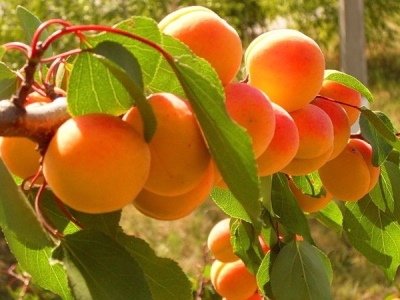
- Name synonyms: Vynoslivyj
- Tree height, m: 5
- Fruit weight, g: 30-45
- Fruit shape: rounded
- Skin : with minimal hairiness
- Fruit color: golden orange with carmine blush
- Pulp color : Orange
- Fruit taste: pleasant sweet
- Appointment: universal
- Ripening terms: average
Growing an apricot tree is the dream of every summer resident, since apricot is very tasty and healthy. It is especially difficult to do this in conditions of prolonged cold winters and a short summer period, since not all species take root and endure frosts. One of the frost-resistant and quickly adapting to harsh climatic conditions is the Hardy apricot.
Breeding history
Apricot variety Vystalivy is a variety included in the collection of breeding achievements of the State Nikitsky Botanical Garden. The apricot was obtained by free pollination using Esperen seedlings. The breeder KF Kostina is considered to be the author of this apricot variety.
Description of the variety
Apricot Hardy is a vigorous tree that grows up to 5 meters in a favorable environment, sometimes even up to 6-7 meters. The apricot is characterized by a rounded crown shape with moderate thickening of bright green foliage. A feature of the tree is the strong branching and drooping of the crown.
Apricot bloom begins in the second half of May. At this time, the voluminous spherical crown is abundantly covered with medium-sized light flowers, emitting an aroma that attracts insects.
Fruit characteristics
This variety belongs to the medium-fruit class. Fruits weighing 30-45 grams ripen on a healthy tree. Apricots have a regular round or slightly flat-round shape with a miniature beak at the top. Ripe fruits are covered with a beautiful golden-orange tone, which is diluted with a carmine blush on the sunny side. The peel of the fruit is rather dense, endowed with a faint velvety pubescence and a beautiful shine. Fruits keep on short and thick stalks, without crumbling even after full ripening.
The harvested crop is well transported and stored for up to 7-10 days in a cool place. Apricots are eaten fresh, processed into compotes, jams, preserves, and frozen and dried. In addition, fruits are used in cooking - filling for baking, jelly, soufflé, decor.
Taste qualities
Hardy is an excellent-tasting apricot. The bright orange pulp has a delicate, fleshy, slightly fibrous, dense and juicy consistency. The taste is sweet, sugar, complemented by a pronounced fruity aroma. A medium-sized stone with a sweetish core is easily separated from the pulp. The advantage of the variety is the composition of the apricot pulp, which contains a huge amount of carotene and vitamin C.
Ripening and fruiting
Apricot Hardy represents a category of mid-season fruit crops. The tree begins to bear fruit in the 5th year after planting. Fruiting of the variety is stable and abundant. You can taste delicious first apricots at the end of July. Mass ripening of fruits occurs in early August.

Yield
Good yield indicators are one of the advantages of the variety. Under intensive agricultural technology and favorable conditions, one tree gives an average of 70 kg of fruit.The maximum figure was recorded at the level of 80 kg per season from 1 healthy tree.
Self-fertility and the need for pollinators
The apricot tree is self-fertile, so there is no need to plant donor varieties nearby. According to experienced gardeners, donor trees can increase yields by 20%. Effective pollinating trees are those that bloom at the same time as the Hardy apricot.
Growing and care
A one-two-year-old seedling is selected for planting. Planting is carried out in the spring (before bud break) or in the fall (a month before frost). It is important to maintain a distance between plantings of 3-4 meters.
The variety is not very demanding in care, but the tree needs watering, feeding, loosening and weeding the soil, forming the crown, removing dry and excess branches, and preventing diseases.



Disease and pest resistance
The tree has a good immune system that protects against many fungal diseases and insect infestations. The only disease that apricots are often exposed to is moniliosis. Preventive treatments with fungicides and insecticides will help to avoid lesions.

Winter hardiness and the need for shelter
Apricot Hardy - the owner of high frost resistance, withstanding critical drops in temperature to -34 ... 40 degrees. It is also worth noting that flower buds are also resistant to cold. The fruit tree does not need shelter for the winter, standard mulching is enough.
Location and soil requirements
Apricot is thermophilic, tolerates short drought well, and also loves the sun and space, since it is endowed with a voluminous crown and root system that grows on the sides.
To grow comfortably, the tree will need a lot of heat, sun and light, as well as protection from wind and draft. The site should be flat, not in lowlands, with deep groundwater. Soils are recommended fluffy, breathable, moisture-permeable, nutritious and not acidic.































































